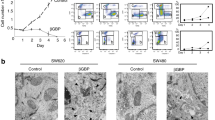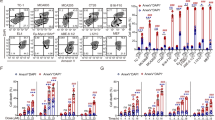Abstract
Toxic-shock-syndrome toxin-1 (TSST-1), a superantigen, can stimulate T cell activation and be used for immunotherapy. In this study, we employed the carcinoembryonic antigen (CEA)-positive LoVo cells to test whether retrovirus-mediated TSST-1 expression could activate human T cells and promote cytotoxicity against tumor cells. We first generated plasmids of pLEGFP-N1-5HRE-CEAp-TSST-1-linker-CD80TM containing a fusion gene of the CEA promoter, 5 copies of the hypoxia-response elements (HRE) as an enhancer, the fragments for TSST-1, and the transmembrane domain of CD80 (CD80TM) and control pLEGFP-N1-5HRE-CEAp (without TSST-1) and generated retroviruses of 5HCTC and 5HC, respectively. After infection with 5HC and 5HCTC retroviruses to establish cell lines, the high levels of TSST-1 expression were observed on the membrane and cytoplasm of the 5HCTC-infected LoVo cells, particularly culture under a hypoxic condition, but not on CEA− HeLa cells. Furthermore, the TSST-1-expressing LoVo cell lysates, but not the control cell lysates, stimulated human T cell proliferation, and the co-culture of the TSST-1-expressing LoVo, but not control cells, with human peripheral blood mononuclear cells (PBMC) induced a high frequency of TNF-α- and IL-2-secreting T cells in vitro, particularly under hypoxic conditions. More importantly, co-culture of the TSST-1-expressing LoVo cells, particularly under hypoxic conditions, but not control cells, with different numbers of PBMC promoted potent cytotoxicity against LoVo cells in a dose-dependent manner in vitro. These data provide proof of the principle that selective induction of TSST1 expression in CEA+ colorectal cancer (CRC) cells activates T cells that destroy tumor cells, particularly under a hypoxic condition. Therefore, our findings may aid in the design of new immunotherapy for the intervention of CRC at clinic.





Similar content being viewed by others
References
Jemal A, Siegel R, Ward E, Muray T, Xu J, Thun MJ (2007) Cancer statistics, 2007. CA Cancer J Clin 57:43–66
Diep CB, Kleivi K, Ribeiro FR, Teixeira MR, Lindgjaerde OC, Lothe RA (2006) The order of genetic events associated with colorectal cancer progression inferred from meta-analysis of copy number changes. Gene Chromosome Cancer 45:31–41
Brabletz T, Jung A, Spaderna S, Hlubek F, Kirchner T (2005) Migrating cancer stem cells, an integrated concept of malignant tumour progression. Nat Rev Cancer 5:743–749
McCormick JK, Yarwood JM, Schlievert PM (2001) Toxic shock syndrome and bacterial superantigens: an update. Annu Rev Microbiol 55:77–104
Marrack P, Kappler J (1990) The staphylococcal enterotoxins and their relatives. Science 248:705–711
Dohlsten M, Sundstedt A, Björklund M, Hedlund G, Kalland T (1993) Superantigen-induced cytokines suppress growth of human colon-carcinoma cells. Int J Cancer 54:482–488
Hao HJ, Jiang YQ, Zheng YL, Ma R, Yu DW (2005) Improved stability and yield of Fv targeted superantigen by introducing both linker and disulfide bond into the targeting moiety. Biochimie 87:661–667
Yang ZF, Poon RT, To J, Ho DW, Fan ST (2004) The potential role of hypoxia inducible factor 1α in tumor progression after hypoxia and chemotherapy in hepatocellular carcinoma. Cancer Res 64:5496–5503
Bussink J, Kaanders JH, van der Kogel AJ (2003) Tumor hypoxia at the micro-regional level: clinical relevance and predictive value of exogenous and endogenous hypoxic cell markers. Radiother Oncol 67:3–15
Semenza GL (1999) Regulation of mammalian O2 homeostasis by hypoxia inducible factor 1. Annu Rev Cell Dev Biol 15:551–578
Ratcliffe PJ, O’Rourke JF, Maxwell PH, Pugh CW (1998) Oxygen sensing, hypoxia-inducible factor-1 and the regulation of mammalian gene expression. J Exp Biol 201:1153–1162
Goonewardene TI, Sowter HM, Harris AL (2002) Hypoxia-induced pathways in breast cancer. Microsc Res Tech 59:41–48
Zhong H, De Marzo AM, Laughner E, Lim M, Hilton DA, Zagzag D et al (1999) Overexpression of hypoxia-inducible factor l alpha in common human cancers and their metastases. Cancer Res 59:5830–5835
Talks KL, Turley H, Gatter KC, Maxwell PH, Pugh CW, Ratcliffe PJ et al (2000) The expression and distribution of the hypoxia-inducible factors HIF-l alpha and HIF-2 alpha in normal human tissues, cancers, and tumor associated macrophages. Am J Pathol 157:411–421
Stragand JJ, Yang LY, Drewinko B (1980) Serum CEA levels in a human colonic adenocarcinoma (LOVO) xenograft system. Cancer Lett 10:45–50
Hsu TC (1954) Cytological studies on HeLa, a strain of human cervical carcinoma, I. Observations on mitosis and chromosomes. Tex Rep Biol Med 12:833–846
Wang W, Sun XJ, Zheng JB, Lu SY (2009) Hypoxia enhances 5HRE and AFPp-regulated NTR/CB1954 suicide gene system in killing hepatocellular carcinoma cell line HepG2. Zhong Guo Zhong Liu Sheng Wu Zhi Liao Za Zhi 16:125–129
Danos O (1992) Construction of retro viral packaging cell lines. Methods Mol Biol 8:17–27
Jiang QL, Wang JM, Jiang S, Wen LM, Zhou H (2003) Large-scale real-timetitration of green-fluorescence-protein-marked recombinantretrovirus: comparison with standard titration method. Di Yi Jun Yi Da Xue Xue Bao 23:1101–1103
Lalvani A, Brookes R, Hambleton S, Britton WJ, Hill AV, McMichael AJ (1997) Rapid effector function in CD8 + memory T cells. J Exp Med 186:859–865
Bergdoll MS, Crass BA, Reiser RF, Crasss BA, Robbins RN, Davis JP (1981) A new staphylococcal enterotoxin, enterotoxin F, associated with toxic-shock-syndrome Staphylococcus aureusisolates. Lancet 1:1017–1021
Sundberg EJ, Li H, Llera AS et al (2002) Structures of two streptococcal superantigens bound to TSST-1-LINKER-CD80TMR beta chains reveal diversity in the architecture of T cell signaling complexes. Structure 10:687–699
Guo X, Evans TR, Somanath S, Armesilla AL, Darling JL, Schatzlein A et al (2007) In vitro evaluation of cancer-specific NF-kappa B-CEA enhancer-promoter system for 5-fluorouracil prodrug gene therapy in colon cancer cell lines. Br J Cancer 97:745–754
Jiang YQ, Wang HR, Li HP, Hao HJ, Zheng YL, Gu J (2006) Targeting of hepatoma cell and suppression of tumor growth by a novel 12mer peptide fused to superantigen TSST-1. Mol Med 12:81–87
Ogata M, Kikuchi H, Ohtsuka E, Kohno K, Ito M, Nasu M (1998) Stimulation of leukaemic cells from adult T-cell leukaemia patients with bacterial superantigens. Br J Haematol 100:490–500
Dang DT, Chen F, Gardner LB, Cummins JM, Rago C, Bunz F et al (2006) Hypoxia-inducible factor-1alpha promotes nonhypoxia-mediated proliferation in colon cancer cells and xenografts. Cancer Res 66:1684–1936
Brown JM, Wilson WR (2004) Exploiting tumour hypoxia in cancer treatment. Nat Rev Cancer 4:437–447
Acknowledgments
This study was supported by grants from the National Natural Science Foundation of China (Grant Serial Number: 30672070, 30400430) and the Key Science and Technology Project of Shaanxi Province (Grant Serial Number: 2009K01-70).
Author information
Authors and Affiliations
Corresponding author
Rights and permissions
About this article
Cite this article
Wang, W., Sun, X., Lu, L. et al. Cytotoxicity of lymphocytes activated by superantigen toxic-shock-syndrome toxin-1 against colorectal cancer LoVo cells. Mol Cell Biochem 376, 1–9 (2013). https://doi.org/10.1007/s11010-013-1561-6
Received:
Accepted:
Published:
Issue Date:
DOI: https://doi.org/10.1007/s11010-013-1561-6




